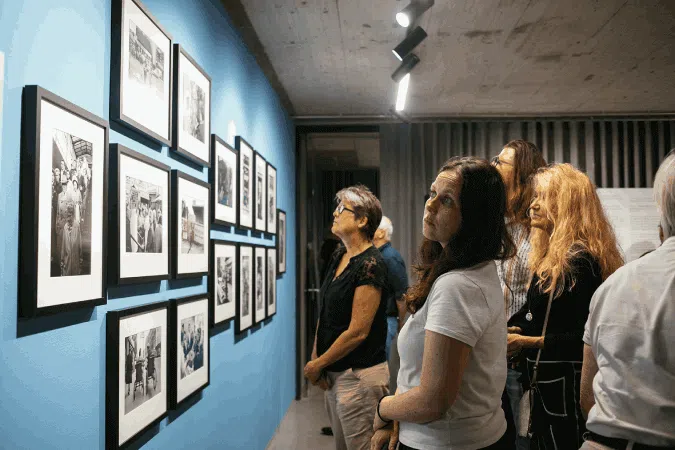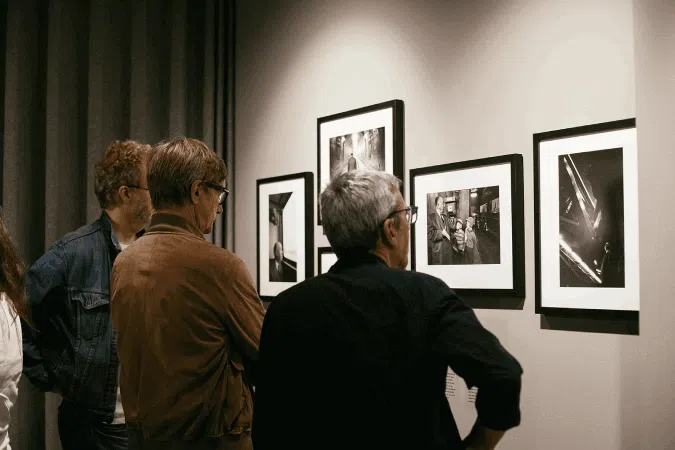Artist: Robert Lebeck
Place: f³ – freiraum für fotografie Berlin Date: September 08 to November 19, 2023
Frame:
CLASSIC Wood 16 in Black oak with matt/glossy white glass
Photography exhibition at f³- freiraum für fotografie
From 8 September to 19 November 2023, the exhibition "Hierzulande" will be presented at f³ - freiraum für fotografie. The exhibition is a tribute to one of the most important German photojournalists, Robert Lebeck, who captured a piece of contemporary German history with his impressive images. The photographs were framed in high-quality wooden frames by HALBE.
The exhibition was kindly provided by the Kunstarchiv Lüneburg and the Archiv Robert Lebeck and curated by Miriam Zlobinski for f³ - freiraum für fotografie.
Table of content
About the exhibition "Hierzulande"
"I've travelled a lot in my photography life, but to capture an exciting photo, all I really needed to do was step outside the front door, and I've done that a lot.”
Robert Lebeck
In “Hierzulande” selected reportages from Germany by Robert Lebeck between 1955 and 1983 are brought together: The photographer knew how to capture moments of historical significance, but also the ordinary lives of people with his camera. From rebellious teenagers in post-war Germany to the political turning points of the Bonn Republic - many of these events are captured in his pictures.
The exhibition presents a wide range of scenes and events: East Berliners shopping on Karl-Marx-Strasse in Neukölln before the Wall was built, the up-and-coming Kampen on the island of Sylt in the 1950s, which was transformed from a tranquil village into a centre of attraction for the upper classes, but also the touching release of the last German prisoners of war in 1955.
But it was not only special historical events that his lens captured; he also artfully recorded people's simple everyday lives. From people exuberantly celebrating carnival to hunger and poverty in the big German cities - these are moments of celebration, joy, suffering, everyday life and history that were captured through Lebeck's lens and still inspire us today. Robert Lebeck was not only a gifted photographer, but also an outstanding observer of life. His images are part of our cultural memory today and remain timelessly relevant.
About the photographer Robert Lebeck
Robert Lebeck, who in the course of his life established a reputation as an exceptional photographer and an important representative of German photojournalism, was born in Berlin in 1929.
He was drafted into the Wehrmacht in 1944 at the age of 15 to fight on the Eastern Front. There he was taken prisoner of war only one year later. After his return, Lebeck completed his A-levels and made the decision to study ethnology in Zurich and New York. During his studies there, his interest in photojournalism was first awakened by US magazines such as Life for the first time
He then began to learn photography autodidactically and worked as a photo reporter from 1952 - initially for various Heidelberg newspapers, and later also for Revue, Kristall, Stern and GEO.

In the 1950s, Robert Lebeck's focus was primarily on photographically capturing the atmosphere of post-war Germany. However, his international fame was to begin with his groundbreaking foreign reportage "Africa in the Year Zero". Especially the photo showing the "Degendieb von Léopoldville" (thief of Léopoldville) was to quickly become his trademark and made him a name in the world of photography.
In the following years, Lebeck travelled a lot: In 1966, he spent two years travelling to New York for Stern. Shortly afterwards, he accompanied the SPD politician and former German Chancellor Willy Brandt on his election campaign tour. His photography was diverse: although he did a lot of political and social photo reportage, he also portrayed numerous writers, artists, musicians and actors - his photographs of Romy Schneider in particular later achieved fame.
At the age of 85, in 2014, Robert Lebeck died in his native city of Berlin. His photographic work, however, received many awards over the years. In 1991, he received the prestigious Dr. Erich Salomon Award from the German Society for Photography (DGPh), and in 2002 he was awarded the Annual Infinity Award from the International Center of Photography in New York. Today, almost 10 years after his death, his photography still remains relevant and is continued to be presented in museums.
HALBE picture frames in action
Lebeck's black-and-white photographs were framed in Wood 16 frames with matt/glossy white glass by HALBE in the colour Black oak. Through the combination of white mounts and black wooden strips, the colours of the photographs are picked up again.
The plain black picture frames harmonise with almost any colour palette and are therefore versatile. Their high-quality creation emphasises the effect of the picture and sets the perfect stage.
If you are interested in a frame that is individually tailored to your picture, please take a look at our frame configurator. There you can easily order your dream frame within a few minutes from home.
